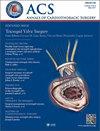From valve-sparing aortic root replacement to aortic root reconstruction: the importance of aortic valve repair.
IF 3.3
2区 医学
Q2 CARDIAC & CARDIOVASCULAR SYSTEMS
引用次数: 0
Abstract
As the term aptly describes, valve-sparing aortic root replacement (VSRR) was initially designed to address patients with primary aortic root pathology and very little to no aortic valve (AV) dysfunction. If present, any degree of aortic insufficiency (AI) was secondary to dilatation of the aortic annulus and/or the sinotubular junction (STJ), in association with the aneurysm of the sinuses of Valsalva. Restoring the anatomy of the aortic root components would thus restore AV function. However, it is important to remember that the functional aortic root is composed of four inter-related parts: the virtual basal ring, the STJ, the sinuses of Valsalva, as well as the AV cusps. In patients with aneurysms of the sinuses of Valsalva, there are inevitably compensatory or pathological changes in the structure of the AV cusps in response to the changes in aortic root dimensions, ranging from elongation to stress fenestrations, especially in areas of high stress near the commissures. Thus, it became evident that restoring the dimension of the annulus and STJ without any attention to the last component parts of the aortic root could result in early failure of a VSRR, including in patients with seemingly normal AV function preoperatively (1). This commenced the era of AV repair. It was soon recognized that residual or induced prolapse of the AV cusps after completion of the VSRR was associated with recurrence of AI and need for reintervention (1). Indeed, as the aortic root dilates and becomes aneurysmal, AV cusps adapt to different extents, which explains the wide variations in severity of AI in patients with similarly sized aortic root aneurysms. Aortic cusps elongate in both their radial and circumferential axes through active, living processes (2). Failure to recognize this at the time of VSSR, and instead restoring to normal AV cusp configuration (effective height, coaptation length and symmetry), as described by the pioneering work of the Brussels and Homburg teams, will lead to failure of the seemingly most straight-forward VSRR procedures for aortic root aneurysms in patients with tricuspid aortic valve (TAV) (3-5). As the applications of VSRR have expanded, a wider group of patients should be considered for these procedures, namely patients with bicuspid aortic valves (BAV) or those with TAVs and eccentric jets of AR. In both instances, there is invariably some element of abnormal cusp structure, typically in the form of cusp prolapse. This is true in the majority of patients with regurgitant BAVs. As has been known in the mitral world for many years, failure to correct cusp prolapse at the time of surgery will negatively impact the durability of the operation. Concepts of BAV preservation and repair are increasingly well understood and standardized (6,7). There is no doubt that most VSRR operations today for patients with BAV and significant AI should involve some element of cusp repair, ranging from raphe release to increase geometric height and leaflet mobility, as well as central plications to fix prolapse and restore effective height. Familiarity with all aspects of AV assessment, both on transesophageal echocardiogram (TEE) as well as intra-operatively, as well as different repair techniques is a pre-requisite. Additionally, it is important to understand the dynamic physiology of the aortic root and the inter-relationships of the different component parts. From valve-sparing aortic root replacement to aortic root reconstruction: the importance of aortic valve repair从保留瓣膜的主动脉根部置换到主动脉根部重建:主动脉瓣修复的重要性。
本文章由计算机程序翻译,如有差异,请以英文原文为准。
求助全文
约1分钟内获得全文
求助全文
来源期刊

Annals of cardiothoracic surgery
Medicine-Surgery
CiteScore
4.60
自引率
0.00%
发文量
58
期刊介绍:
Information not localized
 求助内容:
求助内容: 应助结果提醒方式:
应助结果提醒方式:


